The Intel Haswell-E CPU Review: Core i7-5960X, i7-5930K and i7-5820K Tested
by Ian Cutress on August 29, 2014 12:00 PM ESTEvolution in Performance
The underlying architecture in Haswell-E is not anything new. Haswell desktop processors were first released in July 2013 to replace Ivy Bridge, and at the time we stated an expected 3-17% increase, especially in floating point heavy benchmarks. Users moving from Sandy Bridge should expect a ~20% increase all around, with Nehalem users in the 40% range. Due to the extreme systems only needing more cores, we could assume that the suggested recommendations for Haswell-E over IVB-E and the others were similar but we tested afresh for this review in order to test those assumptions.
For our test, we took our previous CPU review samples from as far back as Nehalem. This means the i7-990X, i7-3960X, i7-4960X and the Haswell-E i7-5960X.
Each of the processors were set to 3.2 GHz on all the cores, and set to four cores without HyperThreading enabled.
Memory was set to the CPU supported frequency at JEDEC settings, meaning that if there should Intel have significantly adjusted the performance between the memory controllers of these platforms, this would show as well. For detailed explanations of these tests, refer to our main results section in this review.
Average results show an average 17% jump from Nehalem to SNB-E, 7% for SNB-E to IVB-E, and a final 6% from IVB-E to Haswell-E. This makes for a 31% (rounded) overall stretch in three generations.
Web benchmarks have to struggle with the domain and HTML 5 offers some way to help use as many cores in the system as possible. The biggest jump was in SunSpider, although overall there is a 34% jump from Nehalem to Haswell-E here. This is split by 14% Nehalem to SNB-E, 6% SNB-E to IVB-E and 12% from IVB-E to Haswell-E.
Purchasing managers often look to the PCMark and SYSmark data to clarify decisions and the important number here is that Haswell-E took a 7% average jump in scores over Ivy Bridge-E. This translates to a 24% jump since Nehalem.
Some of the more common synthetic benchmarks in multithreaded mode showed an average 8% jump from Ivy Bridge-E, with a 29% jump overall. Nehalem to Sandy Bridge-E was a bigger single jump, giving 14% average.
In the single threaded tests, a smaller overall 23% improvement was seen from the i7-990X, with 6% in this final generation.
The take home message, if there was one, from these results is that:
Haswell-E has an 8% improvement in performance over Ivy Bridge-E clock for clock for pure CPU based workloads.
This also means an overall 13% jump from Sandy Bridge-E to Haswell-E.
From Nehalem, we have a total 28% raise in clock-for-clock performance.
Looking at gaming workloads, the difference shrinks. Unfortunately our Nehalem system decided to stop working while taking this data, but we can still see some generational improvements. First up, a GTX 770 at 1080p Max settings:
The only title that gets much improvement is F1 2013 which uses the EGO engine and is most amenable to better hardware under the hood. The rise in minimum frame rates is quite impressive.
For SLI performance:
All of our titles except Tomb Raider get at least a small improvement in our clock-for-clock testing with this time Bioshock also getting in on the action in both average and minimum frame rates.
If we were to go on clock-for-clock testing alone, these numbers do not particularly show a benefit from upgrading from a Sandy Bridge system, except in F1 2013. However our numbers later in the review for stock and overclocked speeds might change that.
Memory Latency and CPU Architecture
Haswell is a tock, meaning the second crack at 22nm. Anand went for a deep dive into the details previously, but in brief Haswell bought better branch prediction, two new execution ports and increased buffers to feed an increased parallel set of execution resources. Haswell adds support for AVX2 which includes an FMA operation to increase floating point performance. As a result, Intel doubled the L1 cache bandwidth. While TSX was part of the instruction set as well, this has since been disabled due to a fundamental silicon flaw and will not be fixed in this generation.
The increase in L3 cache sizes for the highest CPU comes from an increased core count, extending the lower latency portion of the L3 to larger data accesses. The move to DDR4 2133 C15 would seem to have latency benefits over previous DDR3-1866 and DDR3-1600 implementations as well.


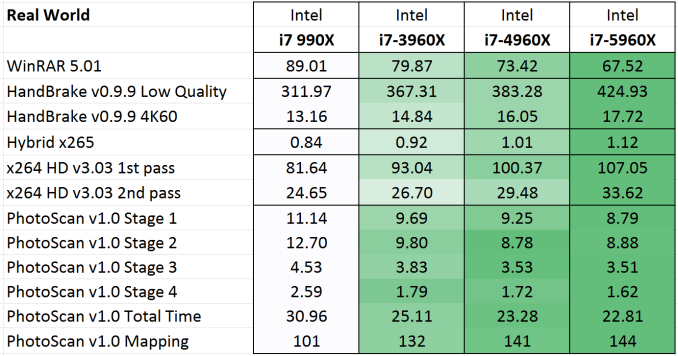


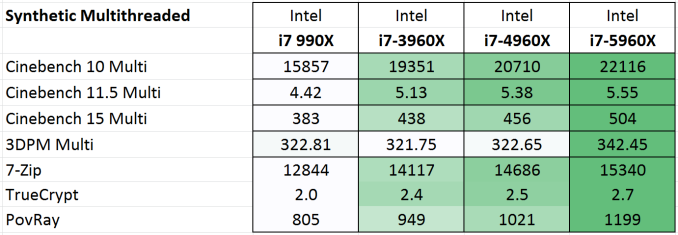

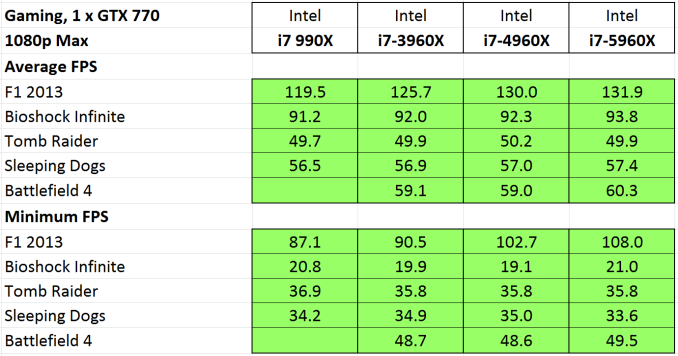
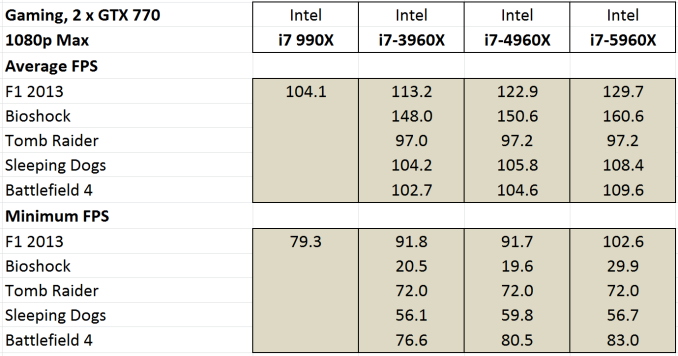
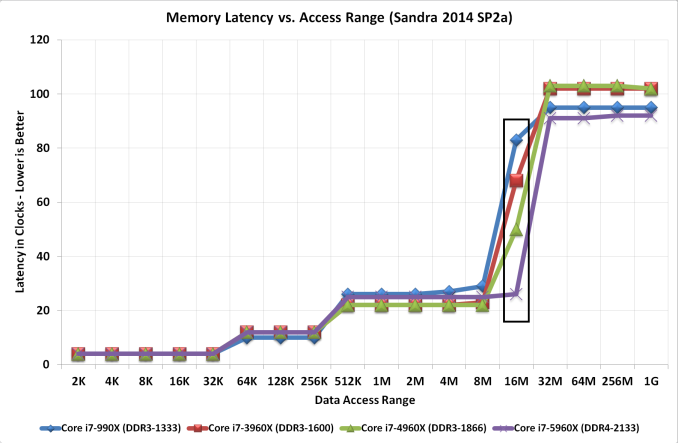








203 Comments
View All Comments
tuxfool - Saturday, August 30, 2014 - link
I'm not so sure it would be of great benefit. Emulators are thread limited by the hardware they're attempting to emulate. I read somewhere that pcsx has a thread limit due to the difficulty in synchronizing each ps2 hardware component in each thread.Dolphin also favors clock speed over simultaneous threads.
bleh0 - Saturday, August 30, 2014 - link
After holding off for 4 years I think it is time for an upgrade. While the builds in the article are good I'm still looking for more.chizow - Saturday, August 30, 2014 - link
Glad I upgraded to Z87+4770K last year. While it is great that Intel *FINALLY* upgraded the rest of their platform to native USB 3.0 and all SATA3 (6G) ports, along with newer options like M.2 and SATA Express, the drop in clocks to accommodate the higher number of cores and higher resultant TDP makes it a wash for my primary purpose: gaming.I also didn't want to have to pay early adopters tax on DDR4, and it looks like that tax is high right now. Coming from X58, I was also very pleased with the drop in total system power going to Z87. I'd estimate between a 920@4GHz and the difference in board power, its pulling about 50W less at idle and 100W less under load. My Kill-A-Watt measurements indicate similar.
Still, if buying today and putting together a new platform for the future, this would be a good option now that Intel has addressed all of the major issues I had with the X79 platform (full native USB 3.0, full native SATA6G, official PCIe 3.0 etc).
@Ian, I am sure it is due to being limited to what you have on hand, but it would have been nice to see some more powerful GPUs tested, just to better illustrate potential CPU performance differences once the GPU bottleneck is lifted. Nice job though, the new graph toggles are really slick.
AsakuraZero - Saturday, August 30, 2014 - link
i was worried about this new processors since i just bought an i7 4770k, and damn im still a happy owner of an amazing chipTEAMSWITCHER - Saturday, August 30, 2014 - link
I pulled the trigger on the 4770K last year also....but I did so only because the Ivy Bridge E was stuck on the X79 chipset. For me, it was an interim solution while I waited for Haswell-E. When my new X99 parts arrive next week, I'll upgrade my system and put the Haswell parts on craigslist - I should be able to sell them for a bargain price and reclaim some cash.AsakuraZero - Sunday, August 31, 2014 - link
the 4770k still sells well on ebay i got mine at 270 (used) looked like new and works likea champ, Haswell e doesnt look bad but in a world where the x86 doesnt use all the cores on many of its applications, or gaming im happy with my purchase, enjoy your CPU and milk every buck out of it!Jonathan_Rung - Saturday, August 30, 2014 - link
"With Haswell LGA1150 CPUs, while the turbo frequency of the i7-4770K was 3.9 GHz, some CPUs barely managed 4.2 GHz for a 24/7 system."I think I spotted a little typo on page 3, did you mean "With Haswell z87..."? I didn't think any of the 4770x CPUs could use an 1150 socket. Or am I misreading it?
Mr Perfect - Saturday, August 30, 2014 - link
The Haswell i7-4770k is socket 1150.http://www.newegg.com/Product/Product.aspx?Item=N8...
Jonathan_Rung - Saturday, August 30, 2014 - link
Oh, you're right. I guess I'm confusing sockets and chipsets. Obviously CPUs need a matching socket, but do they also need a matching chipset, or do newer motherboards just allow newer feature sets introduced by the cpu? Or am I still getting it wrong?It seems like every time a new generation of CPUs are released, a bunch of new motherboards with identical chipsets show up to compliment them, so I thought each generation of CPUs have matching chipset that need to pair with one another.
Sorry, this is like amateur hour, I'll just google this stuff. It's strange, I like reading these articles, but I haven't the slightest idea why - I only understand what they're saying like half of the time!
mcbowler - Saturday, August 30, 2014 - link
at least my dolphin rating is still on top! not sure why that is important.